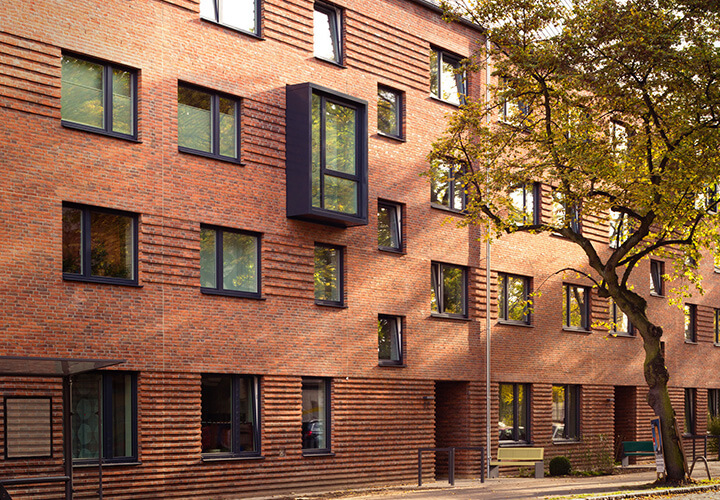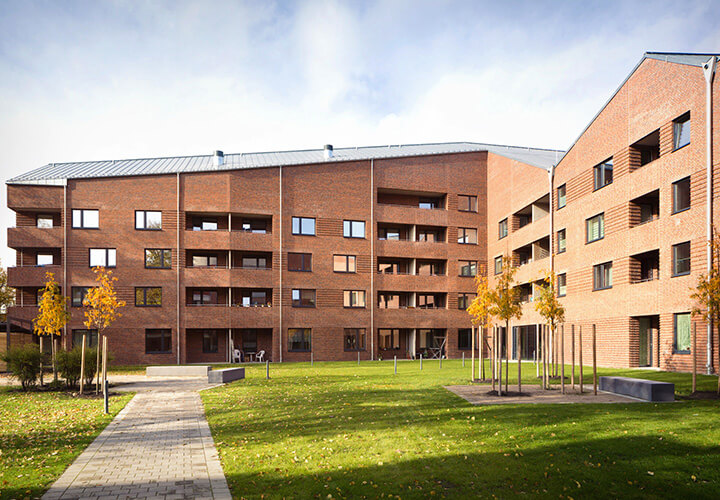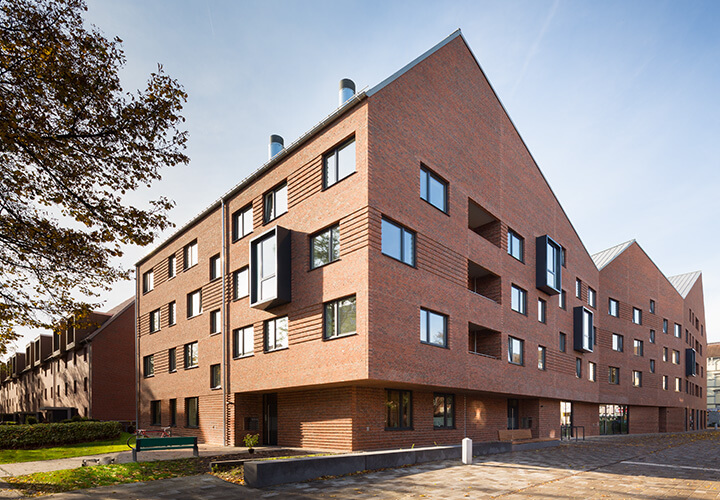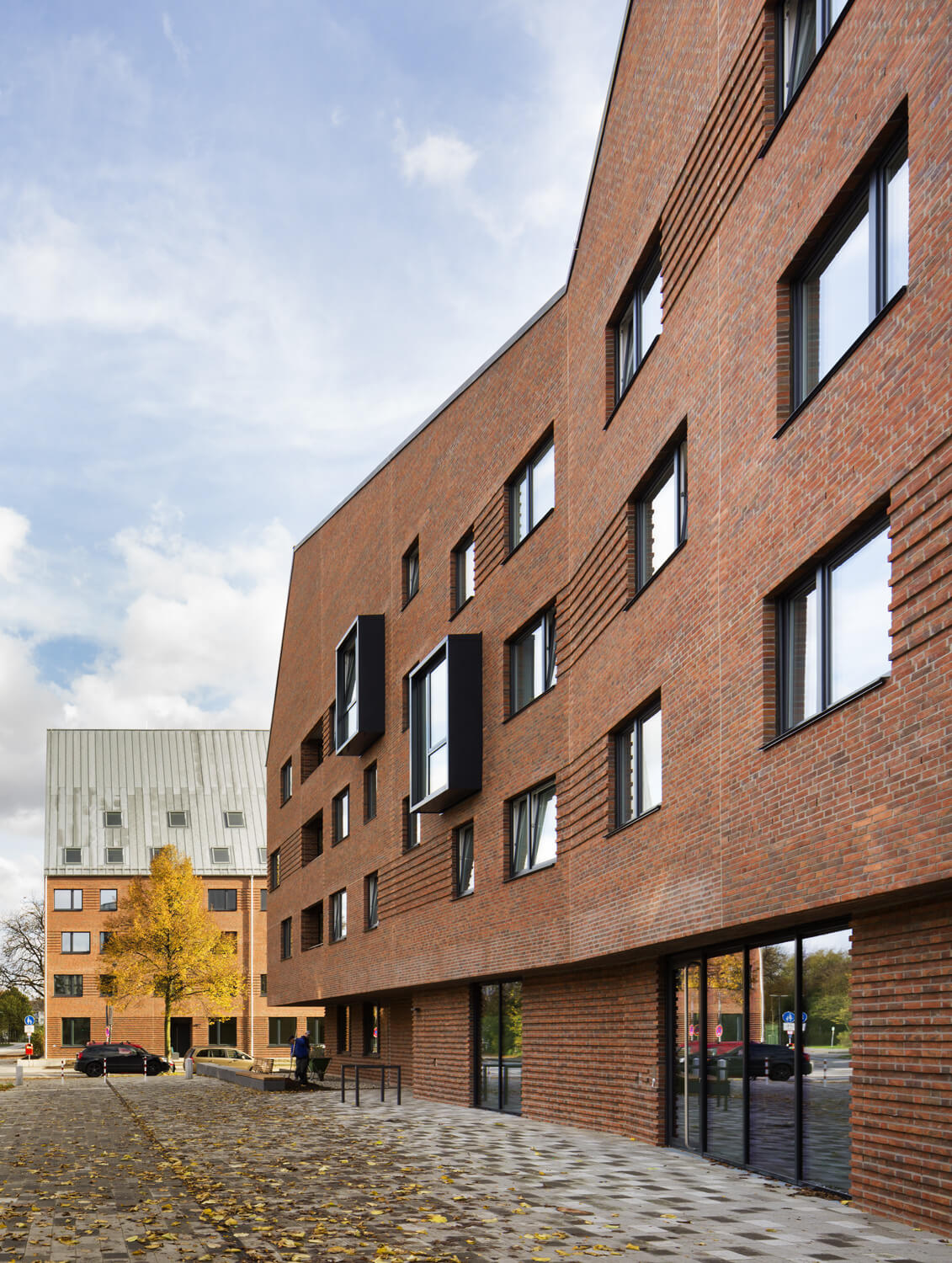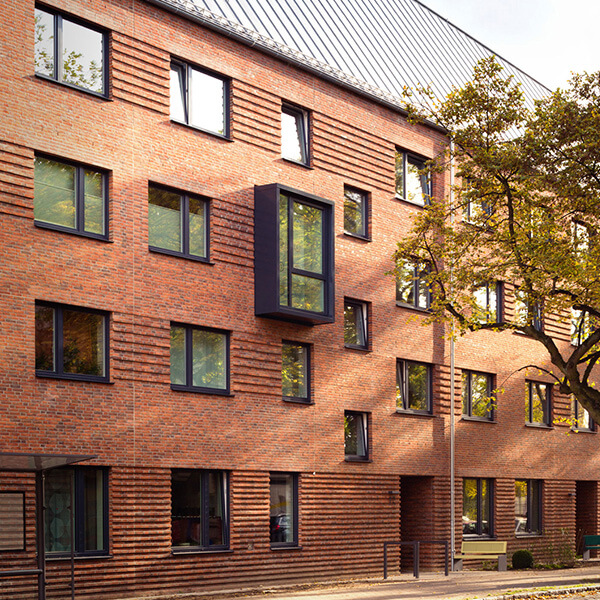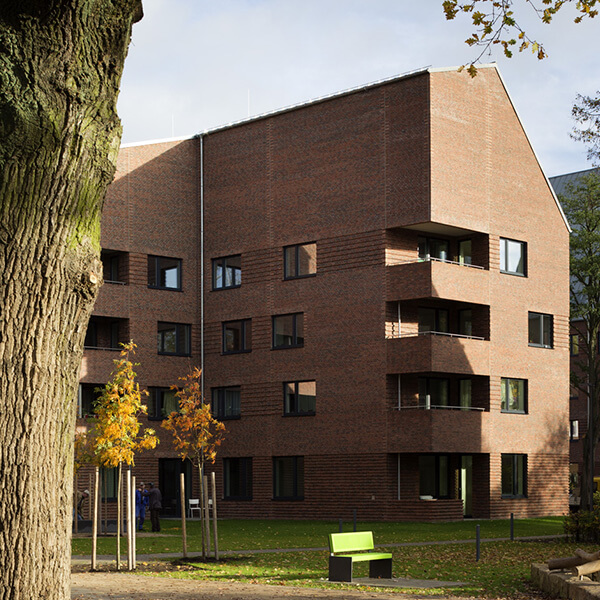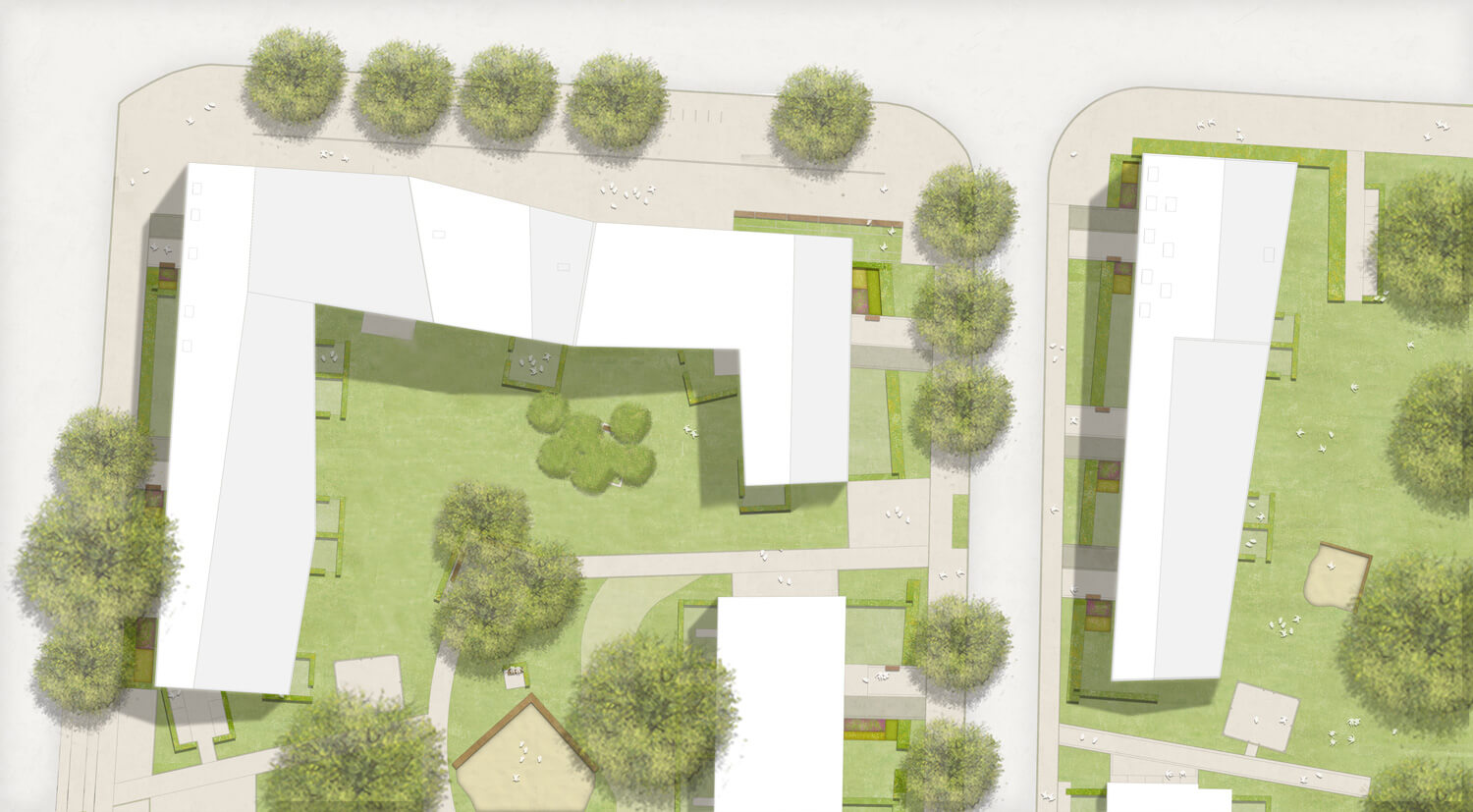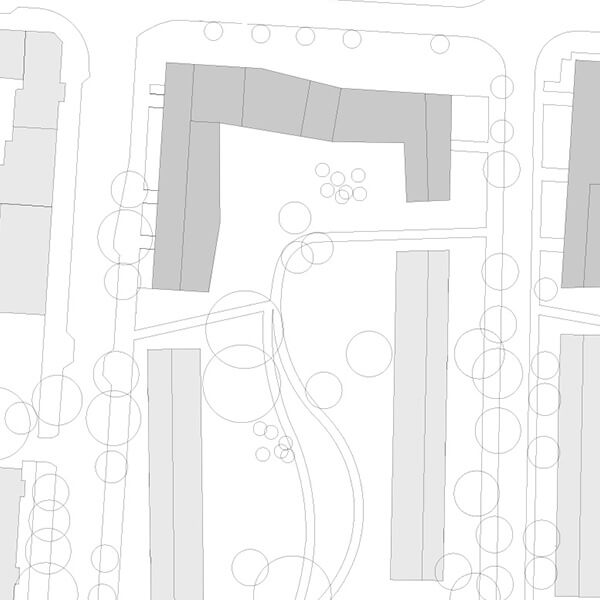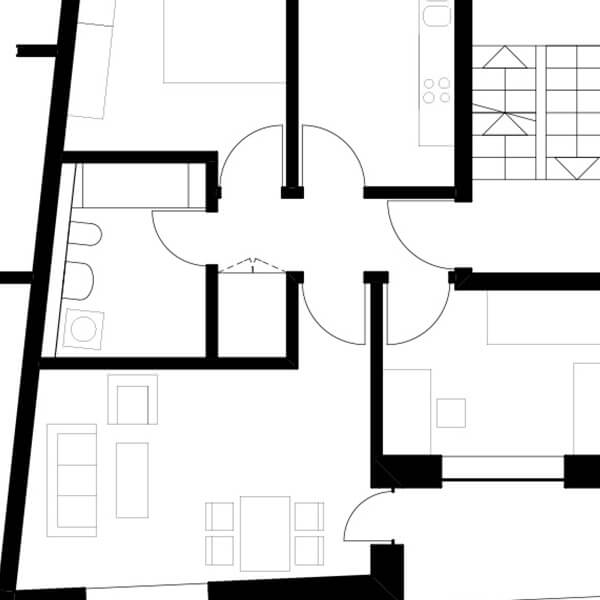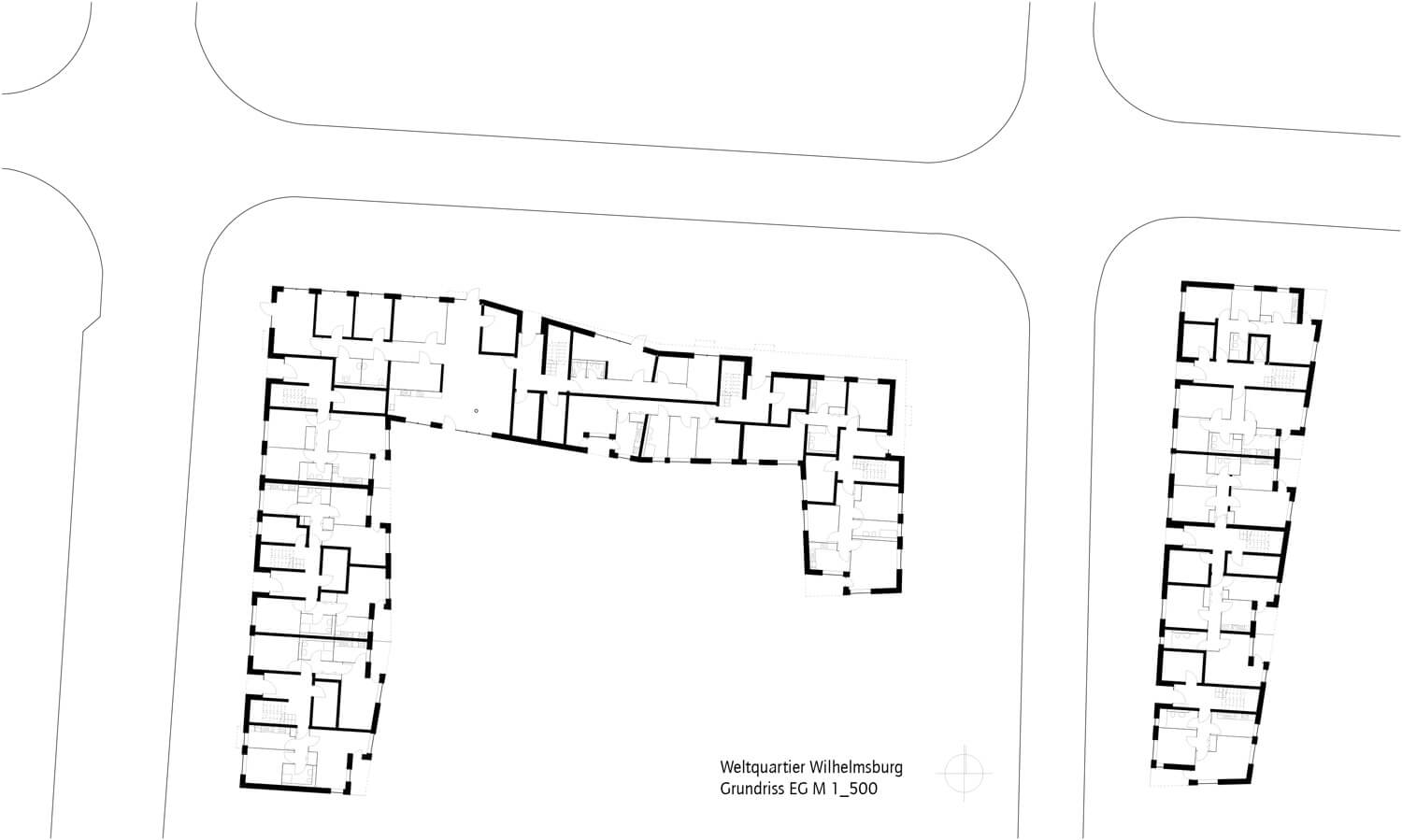Quarter of Nations / Gerber Architekten
Quarter of Nations / Gerber Architekten
Urban planning concept
The district that is the location of the development, the Wilhelmsburg district, is situated within the city of Hamburg between two arms of the Elbe – the Norderelbe and the Süderelbe-Köhlbrand branch. The neighbourhood, which is in the south part of the Reihersteig quarter, is characterized by a traditional workers’ housing development consisting of red brick buildings dating from the 1930s: a three-storey terrace construction with red saddle roofs, which has also been modernised in connection with the IBA. The exceptionally high quality of the existing urban structure resulted in the basic elements of the existing architecture being retained; these were refined and reinterpreted by Gerber Architekten to produce the sculptural head-end structures. The use of a type of brick that harmonises with the existing infrastructure is particularly effective in emphasising and reinforcing the unity of the wider district. The so-called gate buildings represent the northern point of entry to the ‘Quarter of Nations‘, providing a logical conclusion to the block periphery.
The alignments of the new building structures incorporate those of the existing development. The slightly recessed positioning of the U-building allowed a plaza location to be created on the Neuhöfer Strasse. Taken together with the projecting elements of the buildings, this plaza defines the starting point of the district in urban planning terms. The four-storey U-building, with its asymmetrical saddle roof, and the new T-building structure, which is six storeys high in its forward section and four storeys high in its rearward section, respond to the Veringstrasse buildings and the neighbouring Energiebunker.
From an urban planning perspective, the forward elevations of the two head-end structures provide an orientation point for the wider area, and also serve to signal the point at which the ‘Quarter of Nations‘ begins. The green strip running between the Weimarer Strasse and the Veringstrasse is a central element of the ‘Quarter of Nations‘ area. This internal green zone, which resembles a park, is one of the greatest potential assets of the overall plan. Terminating at the U-building, this green strip offers a sense of expansiveness and continuity.
The use of the head-end elements to terminate the block periphery structures lends greater intimacy to the inner courtyard, thereby enhancing it as a place for users to spend their time in. Fitted in between the Torhausplatz plaza to the north and the Welthandelsplatz plaza to the south, it is framed as a coherent space, and unites the various functional requirements both within the community spaces and in the semi-public inner open spaces. The trees already in place on the site are integrated into the open space concept. All inhabitants have the opportunity of tending a green space of their own. These garden islands, which are six by six metres in size and are bordered by hedges, are placed around the outdoor complex in an irregular arrangement, and can be taken on without charge. The community spaces are equipped with seating, play apparatus, structures for drying clothes etc. They are also directly connected to the east-west passage. The garden courtyard has a fluid, meandering route running through it in the north-south direction, which widens out where required. The new network of routes opens up the neighbourhood to the outside area, making it one of the most attractive on the Elbe island.
Architectonic concept
The head-end structures designed for the IBA ‘Quarter of Nations‘ by Gerber Architekten are sculptural pieces of architecture that reinterpret the sloping configuration of the roofs on the existing terraced buildings in their own, autonomous architectural language. They combine this quality with the requirements of a passive building, which must be highly energy-efficient, thereby providing a new and distinctive character for the whole area.
The structures’ sculptural character is particularly well reinforced by the seamless transition of the exterior façade into the roof. The loggias and balconies do not project, but instead remain within the cubature of the structure, thereby allowing the building’s shell to retain a visual impression of unity. A total of 75 housing units of different sizes and forms, ranging from two-room single-person apartments to four-room family apartments, are available in the upper storeys of the U building and on all levels of the T-building. The inclusion of housing for single persons, couples and families helps to promote social diversity. All of the apartments conform to the required standards for subsidised housing, with the rents guaranteed to remain at virtually the same level in order to prevent gentrification.
All of the housing units have a loggia; in the U building, these face toward the inner courtyard. In the T-building, they face toward the public park. In the interior, the loggias connect directly with the living areas, so that they appear to be an extension of the living space. This fluid transition creates a relationship between the interior and the exterior space. On the side that faces the road, the apartments are fitted with large windows. Some of those on the upper levels have full height, frontally positioned bays that suggest ‘sitting in the crown of a tree‘ and additionally enhance the qualities of the apartments’ interior spaces.
In the ground storey zone of the U-building, the areas located toward the Neuhöfer Strasse are used by a day activity centre that primarily caters to individuals with a migrant background. In both the U-building and the T-building, the whole of the ground storey is entirely free of barriers, and entirely accessible. The recessed entrance elements make the access points easily distinguishable. Each of the entrance areas has its own internal designated ground storey space for the storage of bicycles and baby carriages.
Construction and materials
In the implementation of work on the buildings, considerable value was placed on the use of materials that would not be wasteful in terms of resources, and would therefore be appropriate to the commitments associated with social housing provision. The red brick used was worked in the typical Hanseatic fashion, using decorative banding with accentuated recesses and projections. A double-wall, core-insulated system of masonry was used. This allows the U-house to attain the passive building quality standard, and the KfW 40 standard to be retained in the newly constructed T-building element.
The zinc sheeting roof covering was influenced by the container landscapes found in the nearby harbor area, but also by a typical Hamburg form of traditional architecture. The exterior façade blends almost seamlessly into the roof area, ensuring that the roof does not project at the eaves or gable end and thereby preserving the sculptural character of the overall form.
The bays are closed prefabricated steel constructions suspended in front of the façade, clad with pre-coated metal panels and provided with vacuum insulation; this allows the bay walls to be kept as slender as possible. The plastic windows are equipped with triple sun protection glazing, and are provided with a RAL 7016 coating on the outside, ensuring that they harmonize with the colouration of the brick and the bays and thereby give the façade a harmonious profile.
For the interior, mineral materials were used where possible. The loadbearing and non-loadbearing walls alike are built from sand-lime blocks with mineral gypsum plaster or with mineral lime cement plaster, complete with a coating of a paint that has a high diffusion permeability and is emission-free and solvent-free. The concrete floors are provided with a linoleum covering, and the stairwells have a flooring of abrasion-resistant artificial stone. The wet areas have a flooring of acid-resistant ceramic panels.
Energy concept
The energy concept developed for the IBA ‘Quarter of Nations‘ is highly responsible and efficient, featuring optimised systems engineering and regulation and thereby simultaneously reducing environmental impact whilst lowering costs for users.
The head-end structures were built either to the passive building standard or the KfW 40 standard, and are therefore energy-efficient, comfortable, economical and environmentally friendly. With respect to the interior climate, the housing concept incorporates a building shell with a high level of thermal insulation and a mechanical ventilation system with heat recovery capability.
The windows, which can be opened individually for each room, are equipped with sun protection glazing, thereby preventing the excessive heating up of the rooms. Since early 2013, the whole of the ‘Quarter of Nations‘ has been provided with renewable energy from a central energy source, the Energiebunker. The name refers to a former flak bunker dating from the Second World War that has been restored to a fit state in order to serve its new purpose. A woodchip-burning combined heat and power plant in the basement storey allows heating and electricity generation to be concentrated in one place, whilst the solar power system on the roof and on the south façade converts solar energy into heat and electricity.
In the inner space of the bunker, from which the core elements have been removed, the heat is temporarily stored in a 8,000 m³ water container, so that it can be made available to the neighbourhood as required.
Drawings
Extra info
Area:
10520.0 sqm
Project Year:
2014
Project Director:
Jens Haake
Project Leaders:
Britta Küest, Arthur Schiebelbein
Competition and Design Team:
Eckhard Gerber, Hannes Beinhoff, Britta Küest, Anna Radicke
Planning Team:
Britta Küest, Mariella Kiourktsoglou, Diana Vugner, Semra Yüksel, Soudabeh Zerangi, Rüdiger Ameling
Construction Management:
Elke Kutschke, Britta Küest, Claus-Jürgen Tedt
Management Building Process:
Barbara Breitenbach
Landscape Architecture:
Andresen Landschaftsarchitekten Lübeck
Structural Framework:
ISP Ingenieure
HVACR:
KPI Planungsgesellschaft GbR
Sound insulation and room acoustics:
Taubert und Ruhe GmbH
Fire protection:
IFB Schütte
Passive house planner:
IB Rozynski and Dipl.-Ing. Robert Heinicke Architekt, Zertifizierter Passivhausplaner

